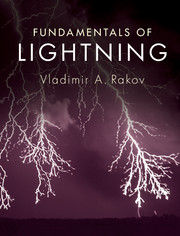Book contents
- Frontmatter
- Dedication
- Contents
- Preface
- 1 Types of lightning discharges and lightning terminology
- 2 Incidence of lightning to areas and structures
- 3 Electrical structure of thunderclouds
- 4 Properties of the downward negative lightning discharge to ground
- 5 Calculation of lightning electromagnetic fields
- 6 Modeling of the lightning return stroke
- 7 Measurement of lightning electric and magnetic fields
- 8 Electromagnetic methods of lightning location
- 9 Lightning damaging effects and protective techniques
- Appendices
- References
- Index
8 - Electromagnetic methods of lightning location
Published online by Cambridge University Press: 05 April 2016
- Frontmatter
- Dedication
- Contents
- Preface
- 1 Types of lightning discharges and lightning terminology
- 2 Incidence of lightning to areas and structures
- 3 Electrical structure of thunderclouds
- 4 Properties of the downward negative lightning discharge to ground
- 5 Calculation of lightning electromagnetic fields
- 6 Modeling of the lightning return stroke
- 7 Measurement of lightning electric and magnetic fields
- 8 Electromagnetic methods of lightning location
- 9 Lightning damaging effects and protective techniques
- Appendices
- References
- Index
Summary
Introduction
There are many individual physical processes in cloud and ground lightning flashes. Each of these processes has associated with it electric and magnetic fields. Lightning is known to emit significant electromagnetic energy in the frequency range from below 1 Hz to near 300 MHz, with a peak in the frequency spectrum near 5–10 kHz for lightning at distances beyond 50 km or so. Further, electromagnetic radiation from lightning is detectable at even higher frequencies, for example, in the microwave, 300 MHz to 300 GHz, and, obviously, in visible light, roughly 1014–1015 Hz. At frequencies higher than those of the spectrum peak, the field spectral amplitude varies roughly inversely proportionally to the frequency up to 10 GHz or so (Pierce, 1977). Also, lightning is known to produce X-rays (up to 1020 Hz or more), although, at ground level, they are usually not detectable beyond a kilometer or so from the source. In general, any observable electromagnetic signal from a lightning source can be used to detect and locate the lightning process that produced it. Only radio-frequency methods are considered in detail here.
Principles of lightning location
General
The three most common electromagnetic radio-frequency-locating techniques include the magnetic direction finding (MDF), time of arrival (TOA), and interferometry. For each of these techniques, the type of locating information obtained depends on the frequency f (or equivalently on the wavelength λ = c/f, where c is the speed of light) of the radiation detected (Rakov and Uman, 2003, Ch. 17). For detected signals whose wavelengths are very short compared to the length of a radiating lightning channel, for example, the very-high-frequency (VHF) range where f = 30–300 MHz and λ = 10–1 m, the whole lightning channel can, in principle, be imaged in three dimensions. For wavelengths that exceed or are a significant fraction of the lightning channel length, for example, the very-low-frequency (VLF) range where f = 3–30 kHz and λ = 100–10 km and the low-frequency (LF) range where f = 30–300 kHz and λ = 10–1 km, generally, only a small number of locations can be usefully obtained. In the case of single location for a cloud-to-ground discharge it is usually interpreted as some approximation to the ground strike point.
Information
- Type
- Chapter
- Information
- Fundamentals of Lightning , pp. 161 - 177Publisher: Cambridge University PressPrint publication year: 2016
